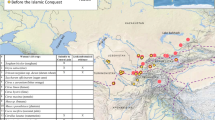Abstract
This study of changes in agrobiodiversity documents the domesticated species and, to a limited degree, the landraces, cultivated in the Siwa oasis of Egypt in 1919, 1924, 1968–1969, and 2004–2006. Siwa is eco-geographically and culturally isolated by more than 300 kilometers (km) from other agrarian communities and, perhaps because of this, detailed observations were made there by a number of agricultural scientists and geographers in a way that provides time-series data lacking from many other agrarian landscapes. Although I have drawn upon Siwan names for crops first published in 1890, this report may be the first substantive record of Tasiwit (Eastern Berber) folk names for traditional crops that allows ethno-linguistic comparisons with Cairene Arabic and other Northern Berber (Tamazight) dialects in North Africa. The perennial crop inventory of Siwan Berbers has remained relatively stable through time and few traditionally cultivated annual species or landraces have been lost. However, additional crop species from other parts of Egypt have been adopted since a paved road was completed to Siwa in 1986 and more Awlad Ali Bedouins have settled and begun dooryard gardens. The reasons for the relative stability of Siwan agrobiodiversity are discussed, and may relate to both the need for crop ecotypes adapted to the challenging alkaline conditions found in Siwan agroecosystems and Siwan pride in and adherence to its traditional cuisine.
Similar content being viewed by others
Literature Cited
Aldumairy, Abd El-Aziz El-Rahman. 2005. Siwa past and present. Yasso, Alexandria, Egypt.
Altieri, Miguel A. and Laura C. Merrick. 1987.In situ.conservation of crop genetic resources through maintenance of traditional agricultural systems. Economic Botany 41(1): 86–96.
Aziz, Heba Abdul. 2002. Opportunities in Siwa oasis. STAT-USA Market Research Reports ID 108334. http://www.strategis.gc.ca [accessed December 2005].
Basset, René. 1890. Le dialecte de Syouah. Ernest Ler-oux, Editeur, Paris.
Belgrave, C. Dalrymple. 1924. Siwa: The Oasis of Jupiter Ammon. John Lane Publisher, London.
Bircher, Alfred G. and Warda H. Bircher. 2004. Encyclopedia of fruit trees and edible flowering plants in Egypt and the subtropics. American University in Cairo Press, Cairo, Egypt.
Brush, Stephen B. 2004. Farmer’s bounty: Locating crop diversity in a contemporary world. Yale University Press, New Haven, Connecticut.
Colley, Charles. 1987. The century of Robert Forbes: Pioneering agriculturist, agronomist, environmentalist and water specialist in Arizona and beyond. Arizona Historical Society, Tucson, Arizona.
El-Assar, A. M., R. R. Krueger, P. S. Devan and C.-C. T. Chao. 2005. Genetic analysis of Egyptian date accessions using AFLP markers. Genetic Resources and Crop Evolution 52:601–607.
Fakhry, Ahmed. 1974. The oases of Egypt: Siwa Oasis. The American University in Cairo Press, Cairo, Egypt.
Forbes, R. 1921a. Agriculture in the Sahara. The Republican. Manuscript on file in the Forbes archives collection, Arizona Historical Society, Tucson, Arizona.
—. 1921b. Siwa oasis. Crop Science Society. Manuscript on file in the Forbes archives collection, Arizona Historical Society, Tucson, Arizona.
Frankel, Otto H. 1970. Genetic conservation in perspective. Pages 469–489 in Otto H. Frankel and Erna Bennett, eds., Genetic resources in plants: Their exploration and conservation. Blackwell Scientific Publications, Oxford, UK.
Hoskins, G. A. 1837. Visit to the great oasis of the Libyan Desert. Longman, London.
Krossman, Martin G. and Hendrickus Joseph Stroomer. 1997. Berber phonology. Pages 461–475 in Alan S. Kaye, ed., Phonologies of Asia and Africa, Volume 1. Eisenbraun Publishers, Winona Lake, Indiana.
Malim, Fathi. 2001. Oasis, Siwa. From the inside: Traditions, customs and magic. Privately published, Alexandria, Egypt.
-. n.d. Siwan Cuisine. Privately published, Alexandria, Egypt.
Nabhan, Gary Paul. 1989. Enduring seeds: Native American agriculture and wild plant conservation. North Point Press, San Francisco.
Popenoe, Paul B. 1913. Date growing. West India Gardens, Altadena, California.
Qualset, C. Q., A. B. Damania, A. C. A. Zanatta, and S. B. Brush. 1997. Locally-based crop conservation. Pages 160–175 in N. Maxted, B. V. Ford-Lloyd, and J. G. Hawkes, eds., Plant genetic conservation: The in situ approach. Chapman & Hall, London.
Stevens, Virginia and Maurice Salib. 2004. A pocket dictionary of the spoken Arabic of Cairo: English-Arabic. The American University Press of Cairo, Cairo, Egypt.
Vivian, Cassandra. 2004. The western desert of Egypt: An explorer’s handbook. The American University in Cairo Press, Cairo, Egypt.
Walker, W S. 1921. The Siwan language. Kegan Paul, Trench, Trubner & Co., London.
White, Arthur Silva. 1899. From sphinx to oracle: through the Libyan desert to the oasis of Jupiter Ammon. Hurst and Blackett, Ltd., London.
Worede, Melaku. 1997. Ethiopian in situ conservation. Pages 290–300 in N. Maxted, B. V. Ford-Lloyd, and J. G. Hawkes, eds., Plant genetic conservation: The in situ approach. Chapman & Hall, London.
—, Tesfaye Tesemma, and Regassa Feyissa. 2001. Keeping diversity alive: An Ethiopian perspective. Pages 143–161 in Steve B. Brush, ed., Genes in the field: On-farm conservation of crop diversity. Cambridge University Press, Cambridge, UK.
Author information
Authors and Affiliations
Corresponding author
Rights and permissions
About this article
Cite this article
Nabhan, G.P. Agrobiodiversity change in a saharan desert oasis, 1919–2006: Historic shifts in tasiwit (Berber) and Bedouin crop inventories of Siwa, Egypt. Econ Bot 61, 31–43 (2007). https://doi.org/10.1663/0013-0001(2007)61[31:ACIASD]2.0.CO;2
Issue Date:
DOI: https://doi.org/10.1663/0013-0001(2007)61[31:ACIASD]2.0.CO;2




